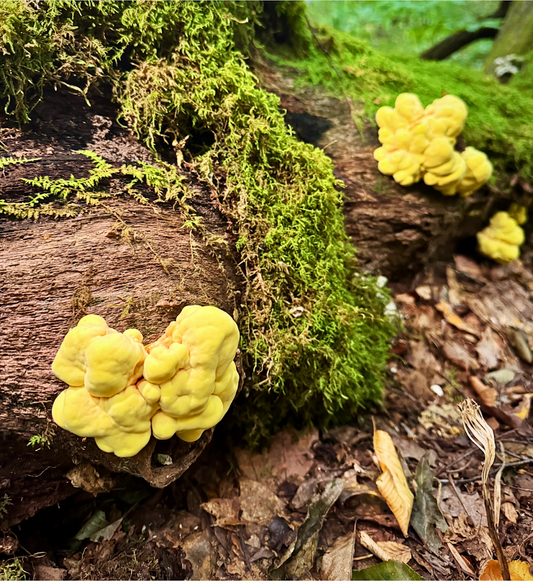
Chicken of the Woods: Nature’s Vibrant Meat Substitute
If you’ve ever wandered through a forest in early summer or early fall and spotted a bright, shelf-like mushroom growing on a tree, you may have found one of nature’s most delicious and eye-catching wild edibles: Chicken of the Woods.
At EmpowerMentality, we believe in reconnecting with the wild for nourishment and healing - and Chicken of the Woods is a perfect example of the abundance waiting in the forest.


What Is Chicken of the Woods?
Chicken of the Woods is the common name for a group of mushrooms in the Laetiporus genus. The most well-known species is Laetiporus sulphureus, but you might also encounter others like L. cincinnatus or L. conifericola, depending on your region.
These mushrooms are easily recognized by their bright yellow to orange fan-like shelves, no gills - instead, you’ll see tiny pores underneath, meaty texture that pulls apart like cooked chicken breast.
It’s not just their appearance that grabs attention - their taste and culinary versatility make them a prized find for wild food enthusiast.
Where and When to Find COW?
Chicken of the Woods typically grows on hardwood trees like oak, beech, and cherry,
occasionally on conifers (mostly in the Pacific Northwest). From late spring through early fall. In shelf-like clusters stacked like petals.
You’ll usually spot them on dead or dying trees, fallen logs, or sometimes even living trees (which may be a sign of internal decay).
Here in the Blue Ridge Mountains, they tend to show up after warm rains - vivid bursts of orange on the forest canvas.
Is It Edible?
Yes - and delicious! Chicken of the Woods is considered one of the best wild edible mushrooms for beginners. Its mild, lemony flavor and dense texture make it a fantastic meat substitute in recipes like:
- Vegan “chicken” noodle soup
- Mushroom tacos or stir-fry
- Lobster roll (lobster meat substitute)
- Sautéed slices with garlic and herbs
- Plant-based mushroom jerky
But be careful:
- Only eat it fully cooked
- Stick to young, tender specimens
- Try a small portion first - some people experience mild stomach upset, especially with mushrooms harvested from conifers or older specimens

Safety First: Harvesting Tips
Chicken of the Woods has very few look-alikes, but proper ID is still crucial. Here’s how to stay safe.
Choose vibrant mushrooms growing on wood, with:
- No gills underneath
- Bright orange or yellow caps
- White spore print
Avoid:
- Mushrooms growing on eucalyptus, cedar, or yew (possible toxins)
- Old, dry, moldy, or bug-eaten specimens
- Foraging from areas exposed to pollution or chemicals
To harvest, use a clean, sharp knife and cut at the base. Leave some behind to allow future growth and support the ecosystem.
Storing and Preserving
Refrigerate fresh slices in a paper bag for up to a week.
Freeze after sautéing or blanching (holds texture well).
Dehydration is less ideal due to toughness but works for soup stocks.
Potential Health Benefits
While Chicken of the Woods hasn’t been as heavily researched as Reishi or Chaga, some early studies suggest it may offer:
- Antioxidant and anti-inflammatory properties
- Antibacterial compounds
- Potential immune support
And, of course, like many mushrooms, it’s a natural source of:
- Fiber
- Potassium
- B vitamins
- Plant-based protein

Final Thoughts
Chicken of the Woods is more than just a beautiful mushroom - it’s a reminder of the richness and nourishment our forests provide. Whether you’re a seasoned forager or new to wild mushrooms, discovering this fungus is like stumbling upon gold in the woods.
At EmpowerMentality, we honor the power of nature in every cup of tea, tincture, or on a plate as a delicious meal - and we hope this inspires you to explore, forage responsibly, and savor the wild.



